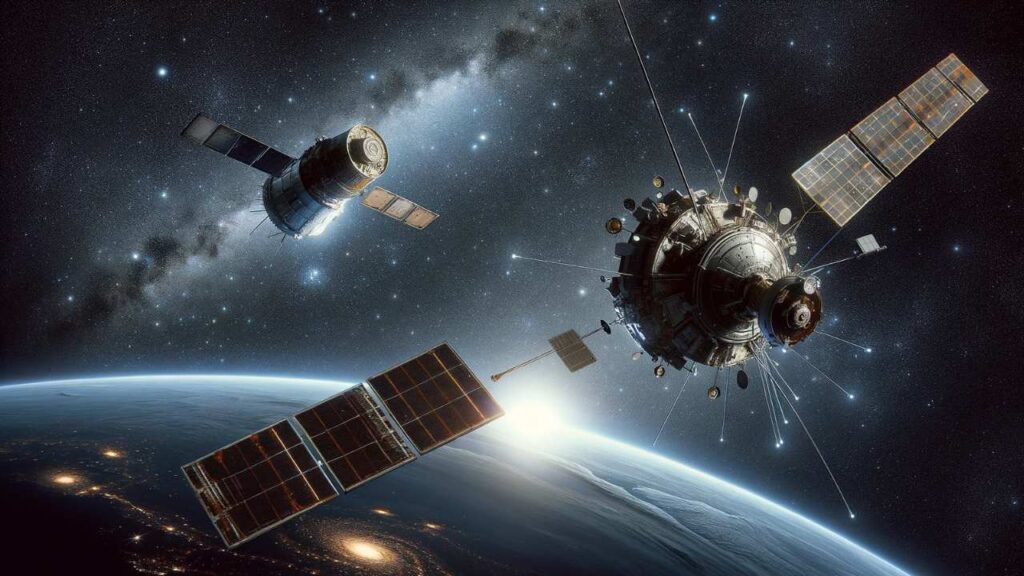“Discover the harrowing moment a defunct Russian satellite nearly collided with a US spacecraft in orbit, underscoring the growing challenge of space debris and the urgent need for effective space traffic management and debris mitigation strategies to ensure the safety and sustainability of space exploration.”

A Close Encounter in Low Earth Orbit
In a recent space event, a NASA spacecraft actively engaged in scientific missions narrowly avoided a collision with an inactive Russian satellite. This incident occurred in the low Earth orbit, a region approximately 373 miles (600 kilometers) above the Earth’s surface. The two satellites involved were NASA’s Thermosphere Ionosphere Mesosphere Energetics and Dynamics (TIMED) mission spacecraft and the defunct Cosmos 2221 satellite from Russia. The near-miss happened around 1:30 am EST on February 28, with NASA releasing a statement about the event just an hour before the potential collision.
The Potential Consequences of a Collision
Had these two satellites, both incapable of maneuvering, collided, the impact would not only have threatened the mission of NASA’s satellite but could have also triggered a catastrophic series of collisions among other objects in orbit. This phenomenon, known as the Kessler syndrome, involves a cascade of debris that can significantly increase the risk of further collisions in space. The scenario, dramatized in the 2013 movie “Gravity,” remains a genuine concern among scientists and space agencies.
Growing Concerns Over Space Debris
The issue of space debris is becoming more pressing with the increasing number of satellites and debris in low Earth orbit. The Department of Defense currently tracks 30,000 of the largest pieces of debris, but countless smaller fragments pose a threat to satellites and the International Space Station (ISS). In fact, the ISS has had to maneuver to avoid debris from a Russian anti-satellite test in 2022.
Efforts to Address Space Junk
Scientists and space agencies worldwide are exploring solutions to the space junk problem. Proposals include using lasers to remove smaller debris and deploying robots equipped to capture and remove space debris. The European Space Agency (ESA) plans to launch a mission in 2025 featuring a four-armed robot designed to grab space junk, hoping this will pave the way for a larger fleet of robotic cleaners. Additionally, ESA’s director general has advocated for new regulations to hold companies and agencies accountable for cleaning up their space debris.
The Close Call: TIMED and Cosmos 2221
The TIMED spacecraft’s mission is to study the effects of the sun on Earth’s atmosphere, contributing valuable data to our understanding of climate and weather patterns. The potential collision with Cosmos 2221, a defunct satellite, threatened not only this scientific endeavor but also posed a risk of initiating a catastrophic chain reaction of collisions, known as the Kessler syndrome. Named after Donald J. Kessler, who first described the scenario in 1978, the Kessler syndrome involves a cascade of debris generated by collisions that leads to further collisions, exponentially increasing the amount of space debris and making certain orbits around Earth hazardous for satellites and human spaceflight.
The Growing Threat of Space Debris
The near-miss between the TIMED spacecraft and Cosmos 2221 was averted thanks to careful monitoring by space agencies. However, it serves as a stark reminder of the growing challenge posed by space debris. Currently, the Department of Defense tracks approximately 30,000 pieces of debris larger than a softball, but there are an estimated hundreds of thousands of smaller, yet still dangerous, pieces of debris that are too small to track but large enough to damage or destroy satellites and spacecraft.
This proliferation of space junk not only endangers valuable satellites and missions but also poses a risk to the International Space Station (ISS) and its crew. For instance, the ISS has had to perform numerous evasive maneuvers to dodge debris, including fragments generated by anti-satellite weapon tests. Such incidents underscore the vulnerability of space assets and the need for proactive measures to mitigate the risk of collisions.
Innovative Solutions to Space Junk
Efforts to address the space debris problem are underway, with scientists and engineers exploring innovative solutions. One proposed method involves using ground-based lasers to nudge small pieces of debris into lower orbits, where they would burn up in the Earth’s atmosphere. Another ambitious approach is the development of space-based robots capable of capturing and removing debris. The European Space Agency (ESA) plans to launch a mission in 2025 featuring a four-armed robot designed to grab and remove individual pieces of space junk. This mission could serve as a proof of concept for a larger fleet of robotic cleaners, potentially offering a scalable solution to the space debris problem.
The Need for Regulatory Measures
In addition to technological solutions, there is a growing consensus on the need for regulatory measures to ensure that spacefaring nations and companies take responsibility for their satellites and debris. ESA’s director general has called for new rules that would require entities launching satellites to plan for their end-of-life, either by deorbiting them or moving them to a “graveyard orbit” away from operational satellites.
Conclusion: Ensuring the Future of Space Exploration
The incident involving the TIMED spacecraft and Cosmos 2221 highlights the urgent need to address the issue of space debris. Through a combination of innovative technology, international cooperation, and responsible space management, it is possible to mitigate the risks and ensure the sustainable use of space for future generations. As we venture further into the cosmos, preserving the safety and cleanliness of our orbital environment is paramount to the continued success of space exploration and utilization.
Other Links-
